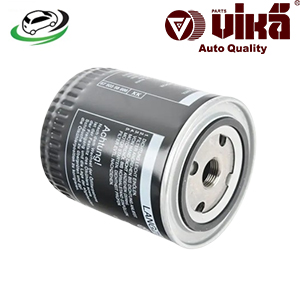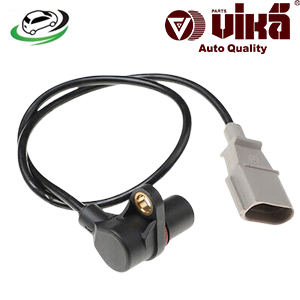-11%
Get Crankshaft Position Sensor Audi B5 A4-1.8T/ C5 A6-2.7T / VW Passat B5-1.8T 078906433A
The crankshaft position sensor is a vital component of an internal combustion engine’s management system. It plays a crucial role in monitoring the position and rotational speed of the crankshaft, providing essential data to the engine control unit (ECU). This data is used to control various engine functions, such as fuel injection, ignition timing, and more. Here’s an in-depth exploration of the crankshaft position sensor, its function, types, benefits, common issues, and maintenance.
1. Function and Role of the Crankshaft Position Sensor
The crankshaft position sensor’s primary function is to monitor the exact position and rotational speed (RPM) of the crankshaft. The crankshaft is a key component of the engine, converting the up-and-down motion of the pistons into rotational motion that drives the vehicle’s wheels. The position of the crankshaft is critical for timing engine operations, such as fuel injection and ignition, which must occur at precise moments to ensure optimal engine performance and efficiency.
The sensor typically reads a toothed wheel or reluctor ring attached to the crankshaft. As the crankshaft rotates, the sensor detects the passing teeth or notches on the wheel, generating a signal that corresponds to the crankshaft’s position and speed. This signal is sent to the ECU, which uses it to calculate when to fire the spark plugs, inject fuel, and perform other engine management tasks.
2. Types of Crankshaft Position Sensors
Crankshaft position sensors come in different types, each with its method of detecting the crankshaft’s position:
- Magnetic (Inductive) Sensors: Magnetic sensors are one of the most common types used in older vehicles. They consist of a permanent magnet and a coil of wire. As the teeth on the reluctor wheel pass by the sensor, they disturb the magnetic field, inducing a voltage in the coil. This voltage signal is proportional to the speed of the crankshaft’s rotation. Magnetic sensors are durable and relatively simple but can be less accurate at very low engine speeds.
- Hall Effect Sensors: Hall effect sensors are widely used in modern vehicles due to their accuracy and reliability. They operate based on the Hall effect, which occurs when a magnetic field interacts with an electric current. These sensors use a semiconductor chip that generates a voltage when exposed to a magnetic field. The teeth on the reluctor wheel affect this magnetic field, creating a signal that the ECU can interpret as the crankshaft’s position and speed. Hall effect sensors are more accurate at a wide range of engine speeds and are less susceptible to interference from external magnetic fields.
- Optical Sensors: Optical crankshaft position sensors use a light-emitting diode (LED) and a photodiode to detect the crankshaft’s position. The reluctor wheel in this case has slots or openings that allow light to pass through as it rotates. The photodiode detects the interruptions in the light beam, creating a signal that corresponds to the crankshaft’s position. Optical sensors are highly accurate but can be sensitive to dirt and debris, which can obstruct the light beam.
- Capacitive Sensors: Less common but increasingly used in specialized applications, capacitive sensors detect changes in capacitance caused by the movement of the crankshaft’s reluctor wheel. They offer high precision and can be used in environments where magnetic or optical sensors may be compromised.
3. Benefits of the Crankshaft Position Sensor
- Accurate Engine Timing: One of the primary benefits of the crankshaft position sensor is the accurate timing it provides for engine operations. By knowing the exact position of the crankshaft, the ECU can precisely control the timing of the spark plugs and fuel injectors, ensuring that the engine runs efficiently and smoothly.
- Improved Fuel Efficiency: Accurate timing and better engine management lead to improved fuel efficiency. The crankshaft position sensor ensures that fuel is injected at the optimal time, reducing waste and improving the overall combustion process.
- Reduced Emissions: With precise control over the engine’s timing, the sensor helps reduce emissions by ensuring that the fuel is burned more completely. This contributes to lower levels of harmful exhaust gases, helping vehicles meet stringent environmental regulations.
- Enhanced Engine Performance: The crankshaft position sensor plays a key role in optimizing engine performance. By providing real-time data to the ECU, it ensures that the engine responds quickly to changes in load, speed, and other conditions, resulting in smoother acceleration, better throttle response, and overall improved performance.
- Fault Detection and Diagnostics: Modern crankshaft position sensors can detect irregularities in the crankshaft’s rotation, such as misfires or mechanical failures. This information can be used by the ECU to trigger fault codes and warning lights, helping technicians diagnose and repair issues more effectively.
4. Common Issues and Failures
Despite its importance, the crankshaft position sensor can experience issues that may affect engine performance or cause the engine to stop running altogether:
- Sensor Failure: Like any electronic component, the crankshaft position sensor can fail due to age, heat, or exposure to contaminants such as oil or coolant. When the sensor fails, it can no longer provide accurate data to the ECU, leading to engine misfires, stalling, or even a complete loss of power.
- Wiring Problems: The wiring that connects the sensor to the ECU can become damaged or corroded over time. This can result in intermittent signals or a complete loss of communication between the sensor and the ECU, leading to erratic engine behavior.
- Reluctor Wheel Issues: The reluctor wheel or toothed ring that the sensor monitors can also experience problems. If the teeth become damaged or the wheel becomes loose, the sensor may produce incorrect signals, affecting engine timing and performance.
- Interference from Other Components: Magnetic sensors, in particular, can be affected by interference from other components that generate magnetic fields. This can result in false readings and incorrect engine timing.
- Dirt and Debris: Optical sensors are particularly vulnerable to dirt and debris, which can obstruct the light beam and prevent the sensor from detecting the reluctor wheel accurately.
5. Symptoms of a Faulty Crankshaft Position Sensor
When the crankshaft position sensor begins to fail, it can manifest in various ways:
- Engine Misfires: One of the most common symptoms of a failing crankshaft position sensor is engine misfires. The sensor provides the ECU with critical timing information, and if this information is incorrect or missing, the engine may misfire or run roughly.
- Stalling: If the sensor fails while the engine is running, it can cause the engine to stall suddenly. This can be particularly dangerous if it occurs while driving, as it can lead to a loss of power steering and braking assistance.
- Difficulty Starting the Engine: A faulty crankshaft position sensor can make it difficult or impossible to start the engine. Without accurate information about the crankshaft’s position, the ECU may not be able to initiate the ignition sequence.
- Reduced Engine Performance: If the sensor is providing inaccurate data, the ECU may struggle to maintain optimal timing, leading to reduced engine performance, sluggish acceleration, and poor fuel economy.
- Check Engine Light: A malfunctioning crankshaft position sensor will often trigger the check engine light on the dashboard. The ECU stores fault codes that can be retrieved using a diagnostic scanner, which can help identify the sensor as the source of the problem.
6. Maintenance and Replacement
Regular maintenance and timely replacement of the crankshaft position sensor are essential for ensuring reliable engine operation:
- Regular Inspection: Inspecting the sensor and its wiring during routine maintenance can help identify potential issues before they become serious. Look for signs of damage, corrosion, or oil contamination.
- Cleaning: In some cases, cleaning the sensor and its mounting area can restore its functionality, particularly if it has become covered in dirt or oil. However, this is typically only a temporary fix, and the sensor may still need to be replaced.
- Replacing the Sensor: If the sensor is faulty, it should be replaced promptly to avoid further engine damage. Replacement involves removing the old sensor and installing a new one, ensuring that it is properly aligned with the reluctor wheel. Depending on the vehicle, this process can be straightforward or require significant disassembly.
- Using Quality Parts: When replacing the crankshaft position sensor, it’s important to use high-quality, OEM (Original Equipment Manufacturer) or equivalent parts. Cheap, low-quality sensors may not provide the same level of accuracy and reliability, leading to ongoing issues.
- Regular Diagnostic Scans: Performing regular diagnostic scans can help detect issues with the crankshaft position sensor early on. Modern vehicles have sophisticated onboard diagnostic systems that can alert you to sensor problems before they lead to more serious symptoms.
7. Importance in Modern Engines
In modern engines, the crankshaft position sensor is more important than ever. As engines become more complex, with variable valve timing, direct fuel injection, and other advanced features, the need for precise timing data is critical. The crankshaft position sensor provides this data, ensuring that the engine operates at peak efficiency and performance under all conditions.
Additionally, the sensor plays a key role in safety systems such as traction control and stability control, which rely on accurate engine speed information to function correctly. As a result, a failing crankshaft position sensor can have far-reaching effects on vehicle safety and drivability.
Follow us on Facebook for more parts.



